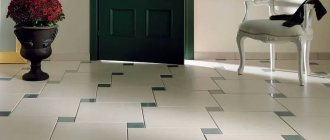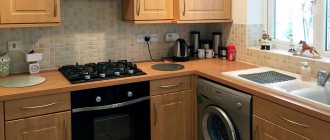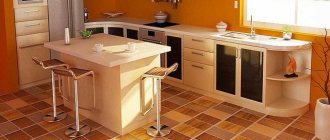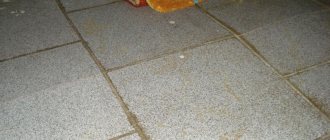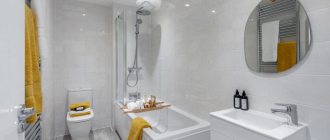Everyone who has done renovations has faced the problem of how to choose tiles for the kitchen floor. Finishing the kitchen floor with ceramics is a successful option from both an aesthetic and environmental point of view, and also has performance characteristics. The design of kitchen floor tiles plays a key role in interior design: it supports the style and color scheme of kitchen furniture, wall cladding and decorative elements. By choosing a beautiful floor covering with excellent strength properties, you will give your kitchen interior an impressive look for many years to come.
Requirements for kitchen floor surfaces
In a room with high humidity, where water is often spilled, the flooring should be practical and wear-resistant. When choosing tiles for the kitchen floor, you should not think about design first. Beauty will fade into the background if in a year the tiles crack, become covered with chips and cracks.
Characteristics that guarantee the durability of the floor surface:
- Wear resistance class. This indicator is determined using a special international PEI scale. For the kitchen, choose packaging with the number 3, 4 or 5.
- Resistance to aggressive detergents. The flask icon on the product box indicates how resistant the tile is to the chemicals that are used daily to clean kitchen floors. The best option is class “A” or “AA”.
- Slip level. One of the important indicators, since we are talking about a “slippery” room in the house. The value is at least 0.75.
- Moisture resistance. The product is vitrified, then water will not penetrate inside. Porous tiles absorb liquid, leaving stains on the surface, which is especially noticeable in plain colors.
- Degree of hardness on the Mohs scale. For a kitchen floor, a minimum of the seventh mark is required, then the tiles will last a long time without chips, scratches or mechanical damage.
There is also an indicator of resistance to burnout. It is marked with a sun on the packaging. But kitchen floors are not often exposed to direct sunlight, so this feature is not of primary importance.
There are hundreds of different manufacturers, domestic and foreign companies, on the ceramic coating market. The criteria are approximately the same for everyone, and the main indicators are determined by GOST.
Everything you need to know about tiles in the kitchen:
Specifications
- Wear resistance
- Hardness
- Friction coefficient
- Chemical resistance
- Water absorption coefficient
Dimensions: what to focus on?
Design Features
- Color
- Imitation of stone and wood
How to choose grout?
Ceramic tiles for kitchen flooring have many advantages: wear-resistant, environmentally friendly, durable, and easy to clean. In addition, the choice is really wide: you can find products for every taste and budget.
But there are also disadvantages. Tile is a cold material; it does not heat up even in the hot season. If you like warm floors, which is especially important in winter, you cannot do without installing the appropriate system. In addition, it has poor sound insulation - this should also be taken care of at the installation stage.
Instagram @anna_mikheeva_design_studio
ETRURIA design
Cersanit
Instagram @gretafoto_ru
Types and formats of floor tiles
At enterprises, ceramics are sorted by caliber, which indicates the dimensions inside the package. Manufacturers of low-quality goods neglect such marks; the buyer will find in the box products that differ in width and length.
The shape of kitchen floor tiles can be rectangular or square. Non-traditional geometric shapes in the form of a hexagon, octagon, circle, trapezoid are also found, but they are more expensive and require high skill of the installer.
The size of the material is directly proportional to the area of the room. For a spacious kitchen, you can choose large slabs with a side of 35-40 cm. If you need to visually enlarge the room, designers recommend using rectangular products or placing squares diagonally. A medium-sized tile (20 by 20 cm or a little more) is suitable for a small kitchen.
There are 3 types of ceramic floor coverings, distinguished by the material used:
- Tile.
- Porcelain tiles.
- Quartzvinyl.
Production methods are also different. There are pressed products - durable, practical and moisture resistant. The second option is extruded - slabs with a porous structure.
What size to choose
The dimensions of the tiles correspond to the area of the kitchen. For a small-sized room, small-sized ceramic tiles are better suited: 20*20, 30*30 cm. If the kitchen is combined with a spacious living room or the area allows you to roam around, use larger sizes: 40*40, 50*50, 60*60 cm.
Common dimensions in rectangular shape (in cm):
- 15*30;
- 20*30;
- 30*40.
If the kitchen floor is not level, it is better to use a small format, it helps to visually eliminate defects. The thickness of the floor slab ranges from 6.5 to 11 mm, and the strength of the coating depends on it. To calculate the quantity, you need to divide the kitchen area by the size of 1 tile; it is desirable that you get an even number of elements, then the material will not need to be trimmed.
The caliber matters - this is the difference between the actual size of the tile and what is indicated when selling. They may differ by 5-7 mm; this is not a defect, but a manufacturing feature. For example, instead of 20*20 cm, you may find 19.5*19.5 cm or 20.5*20.5 cm. Before you start laying, you need to track this moment and correctly distribute the tiles over the area so that the result is even.
Caliber designation on packaging
Advantages and disadvantages
You should consider the advantages and disadvantages of each individual type of ceramic tile.
| Material | pros | Minuses |
| Tile | Durability, reasonable price, long service life, ease of maintenance, environmental friendliness, fire resistance, damaged floor area is easy to replace | The material is cold and slippery and requires careful surface preparation before installation. It has low sound insulation |
| Porcelain tiles | Wear resistance, clear pattern, strength | Heavy slabs are very fragile and difficult to lay |
| Quartzvinyl | A floor made from this material is warm, non-slip, and easy to install. | Difficulty in transportation due to the heaviness of the slabs |
All shortcomings of any type can be corrected. Sound insulation will be enhanced by an additional layer of special material, cold tiles will be corrected by the “warm floors” system, and the textured surface will reduce slipping.
Features of choosing ceramic tiles for the kitchen
The first thing that catches your eye when entering the kitchen is the apron, or as it is also called a “pocket.” It performs several functions at once.
The first purpose, of course, is aesthetic emphasis. A well-chosen outline sets the tone for the entire room. The second mission is to protect surfaces from grease and dirt. With regular washing with household products, the “pocket” can serve you for a long time. When purchasing, take care to calculate the sizes in advance. The classic size of the working area is about 50 cm in height. Don’t forget about the presence of hoods, hanging cabinets and other kitchen furniture.
The common type of “boar”, a tile with beveled corners, shaped like a small boar, looks very good on the work area, due to the optical increase in space.
Kitchen floor tiles are the best solution to avoid damage to laminate boards or parquet. When cooking, something always spills, falls, gets dirty, ceramics can handle all of these perfectly. The only thing you need to select is a tile with thermal protection, because it would be sensible to install a “warm floor” to protect your household from the cold. When tiling walls, it is advisable to follow two rules:
• Noise insulation.
Any coating will not protect against noise, and it is preferable to insulate the walls before laying out the layout.
• Material weight.
The massive slab that you selected for the floor will not be suitable for the wall, only because it may simply collapse later under the force of gravity.
Color and tone
It is important to know here that the tiles can differ significantly in shade if they are from different batches. The store must be warned about this. A responsible manufacturer marks the product with special markings.
Before purchasing, you should make sure that each box has the same symbol of the product type.
What to do if the tiles are still different or the purchased material was not enough and you had to buy another package from a different batch. Some design tips:
- choose the closest possible tone;
- calculate the masonry so that the visible part of the floor is the same;
- hide the boundaries of difference under the kitchen set and other furniture.
To avoid such problems, it is better to make sure in advance that all products are the same color, but to do this you will have to open the packaging.
Expert opinion
Olga Kovalenko
Since 2010 I have been engaged in interior design and architectural design.
For the kitchen, it is better to choose tiles with a matte finish, which are more practical to use.
Design
Only a kitchen where the nuances are thought out to the smallest detail and the colors are in perfect harmony with each other will become cozy and beautiful. Not only the preferences of the owners of the room are important, but also the features of the chosen style.
- Any tile will suit a light set, but it is best to “warm up” a cold shade with brown or terracotta.
- A monochromatic floor design is chosen in cases where the furniture is in bright colors and the kitchen itself is made in a modern style (high-tech, minimalism).
- A pattern imitating wood or stone looks good in loft architecture, but only if the furniture set differs from the texture of the flooring.
- Antique ornaments, patterns, aged ceramics - options for classics, Provence or country.
- Black is not the best color for a kitchen floor. A dark coating will have to be washed much more often, as dust, dirt, and stains are more visible on it.
- It is not recommended to choose a large pattern for a small area, so as not to visually reduce it further.
Ceramic tiles of neutral colors and imitation of natural materials are ideal for kitchen flooring. Modern technologies make it possible to lay products without visible seams so that it is impossible to distinguish tiles from real wood or stone.
Pros and cons of tile floors in the kitchen
Ceramic tiles have many more advantages than disadvantages:
- Due to its smoothness and antistatic properties, it is very easy to clean and is not afraid of aggressive cleaning agents.
- Can last in good condition for at least 15 years.
- It withstands flooding, burning, and temperature changes (unlike wood/laminate).
- Allows you to locally repair the floor, replacing only damaged areas.
- Ceramic/tiles are cheaper than porcelain tiles, parquet and wooden boards, and even more so stone, but can adequately imitate the textures of natural materials.
- The variety of colors, textures, tile sizes and masonry patterns allows you to create a unique floor design and even correct some of the shortcomings of the room.
And here is a list of the disadvantages of tiles and ways to minimize them:
- Ceramics are very cold, so it is advisable to combine it with a heated floor system (fortunately, the material has excellent thermal conductivity). You can also tile only the work area, and decorate the dining room with a warmer material - wood. The photo below shows an example of combined floors with tiles and laminate.
However, you can do it even simpler and lay rugs on the floor and get into the habit of moving around the kitchen in slippers.
- Another disadvantage of ceramics is poor sound insulation, which can be corrected with an additional sound-proofing layer.
- The tile is somewhat dangerous due to its slipperiness and hardness. Bruises on a tile floor are more painful than on wood or linoleum.
- Ceramic can crack if you drop something heavy on it, say a cast iron frying pan. By the way, dishes that accidentally fall on the floor will inevitably break.
- Laying tiles is quite a troublesome and messy task. It is necessary to accurately calculate the consumption of material, lay it correctly, and most importantly, make the base perfectly level. After all, if there are voids under the tile, it will definitely crack. Therefore, it is best to trust all repair work to master tilers, and not take on the job yourself.
Laying methods
When the color and shape of the tiles are chosen, installation of the product begins. Here everyone decides for themselves whether to trust the master or start styling with their own hands. The methods differ according to the type of masonry:
- Traditional. The figures line up corner to corner. This method is suitable for single-color tiles or a checkerboard layout.
- Bias. It will help you create an original floor design from a modest and discreet base.
- Diagonally. A modern solution for a small kitchen space. Thanks to this method, you can visually lengthen the room.
- Imitation of parquet pattern. It is difficult to perform this installation option without experience and skills.
- Modular grid. The tiles are laid in a special pattern, which is difficult for a beginner to imagine and design; it is better to entrust the work to a master.
- Christmas tree with attachment. Not suitable for material with a catchy design or pattern. Using small inserts, a composition with bright splashes is created.
Expert opinion
Olga Kovalenko
Since 2010 I have been engaged in interior design and architectural design.
The size of the tiles should be a multiple of the width and length of the room, so that there is as little trimming of solid products as possible.
Grout options
There is a special mixture for decorating seams, which can be applied in several ways:
- choose a color to match the coating to completely hide the seams;
- emphasize the geometric pattern using contrast (black tiles - white stripes);
- use a clear mixture. Suitable for surfaces with an ornamental pattern, a special play of colors, or a variegated pattern.
If there is high humidity in a house or apartment, it is recommended to use epoxy grout. It prevents the appearance of black mold and mildew and is impervious to moisture. This option is more expensive, but will eliminate problems with dampness.
Important nuances
Repair is not only labor-intensive, but also a very expensive process. Kitchen tiles are expensive, and it would be a shame if they cracked in a month as a result of the installer’s mistakes.
To prevent this from happening, you need to know a few rules.
- Surface preparation. The old coating is dismantled to obtain a smooth screed.
- Cleaning and priming the substrate before laying tiles on the floor. It is important to remove debris and dust from it for better adhesion of the glue.
- Compliance with technology. Even a small error will lead to the formation of an air gap, destruction of a section of the floor and dismantling of the entire surface.
A decorative plinth will complement the covering, give it an aesthetic appearance, and complete the stylistic accent of the interior.
Material Selection Basics
For many decades, decorative ceramic tiles have traditionally been used to decorate kitchen interiors. If your old finish has been in need of updating for a long time, then there is no need to rush into buying a new one. First of all, you should learn how to choose the right tiles:
Computer deskthe material chosen for the design of the floor and walls must be highly resistant to mechanical abrasion and stress. This is very important, given the operating conditions in the kitchen, which is considered one of the most visited and cleaned rooms in the house;
- the material must successfully withstand impacts and accidental falls of dishes;
- the coating must be able to cope with the negative effects of household chemicals, elevated temperatures and humidity;
- tiles intended for decorating the floor surface must have anti-slip properties;
- The material for decorating surfaces in the kitchen should maintain a pleasant atmosphere.
Care
Proper installation will not ensure longevity of kitchen tiles if its surface is not taken care of.
- glossy material cannot be cleaned with a wire brush or abrasives;
- greasy stains can be easily removed with vinegar dissolved in water;
- wax mastic and various hydrophobic agents will help create a protective layer on the surface and prevent the accumulation of dirt;
- The water for cleaning tile floors should be warm or hot.
At the dry cleaning stage, the surface covered with ceramic tiles is vacuumed or swept with a soft brush to remove sand particles and large debris. Then use a napkin with a suitable detergent to remove dirt in a circular motion, rinse the floor with clean warm water, removing any remaining soap solution.
Ceramic tiles are the leader among finishing materials for kitchen floors. But it is recommended to buy this product in trusted places, and give preference to well-known brands with a worldwide reputation.
Characteristics
According to EN ISO 13006 and GOST 6787-2001, there is a whole class of indicators that together determine the suitability of tiles for use in certain conditions. These include
Forming method and water absorption
Water absorption table.
Note that Russian glazed and unglazed floor tiles are produced only by pressing. Therefore, it is better for the kitchen to purchase domestic products with a protective glaze.
Bending resistance
This is the limiting value of the static load applied to 3 points of one element, which the test sample can withstand without destruction. Measured in N/mm² (ISO 1054-4 standard), for tiles it has the following minimum values:
| Tile category | Meaning |
| BIb | 27 |
| BIIa | 20 |
| Bllb | 16 |
That is, for example, kitchen tiles of category BIb can withstand loads of up to 270 kg/cm² or 27 MPa.
Surface hardness
This is the ability of a surface to be resistant to scratching and other damaging factors. Typically, the well-known MOHS mineral hardness scale is used. For glazed tiles, the optimal value is not lower than 5.
That is, the higher the indicator, the lower the risk of damage from falling objects, heels, animal claws, etc. A competent master will select flooring material with a surface hardness level of at least 6 units.
Resistance to temperature changes
This is the ability of good enamel not to crack or change during sudden changes in temperature (temperature shock). If you choose the wrong material, then due to drops of hot oil, boiling water or concentrated detergent hitting the surface, swelling or a network of small cracks may form at the contact point.
Chemical resistance
This parameter reveals the surface’s ability to withstand chemicals, including household chemicals, stain-forming liquids or products, salts, and acids. To determine this, a whole series of tests is carried out on the contact of the tiles and an aggressive environment.
| Class | Meaning |
| AA | According to the test results, there are no visible changes in appearance |
| A | After interaction, minor surface defects appear |
| IN | Changes after testing are average |
| WITH | Partial loss of original appearance |
| D | Complete loss of presentable exterior |
Frost resistance
This is the ability of a ceramic product not to collapse when immersed in water and cooled below 0 °C. It is measured by the number of freezing and thawing cycles and directly depends on the water absorption coefficient - the lower it is, the higher the frost resistance. Not relevant for interior spaces.
Abrasion resistance
This test for unglazed tiles is performed using cast silica (a synthetic abrasive). The value of the volume of the erased surface of the product obtained after testing allows us to assign a certain class of use to the tile according to UPEC. For glazed products, another indicator is used - PEI.
| Class | Meaning |
| P.E.I. | Operation with a minimum content of abrasive particles (bathrooms, bedrooms) |
| PEI II | Use in rooms with a small amount of abrasive components (offices, bedrooms, etc.) |
| PEI III | Use at an average level of abrasive particles (hallways, kitchens, cottage halls) |
| PEI IV | Installation in places of intensive use (canteens, shops, restaurants) |
| PEI V | Application in buildings with a high level of operational load (public places, industrial facilities) |
If you try to save money and put PEI I class tiles on your kitchen floor, you can rest assured that the coating will serve properly at best for about a year, or even less.
Slip resistance
This so-called safety criterion is not mandatory, but for some series of tiles it is considered necessary (swimming pools, locker rooms, public places, etc.), so manufacturers try to indicate the anti-slip coefficient on the packaging.
| Tilt angle, in ° | Group |
| 3-9 | R9 |
| 10-19 | R10 |
| 19-27 | R11 |
| 27-35 | R12 |
| >35 | R13 |
In fact, it would be a good idea to take this indicator into account if you plan to lay tiles in the hallway of a private house (without a “dressing room”) or the lobby of a public building. After all, in winter, snow that sticks to shoes quickly melts in the warmth. And it is very easy to slip on the puddles that form. This problem is especially typical for glossy tiles with a polished surface. Matte products in this regard are safer in the kitchen, hallway or hall.
Matte tiles in the interior.
For all of the above characteristics, their own pictograms have been developed.
A set of basic pictograms for tiles.
The kitchen, hallway, hall, corridor are all places with an average level of traffic; liquids, fine sand or substances that form a slippery surface may appear on the floor. Therefore, you need a tile with the following values:
- water absorption coefficient up to 3%;
- hardness above 5 units;
- classes AA or A;
- abrasion index PEI ≤II;
- safety category – R9-10.

